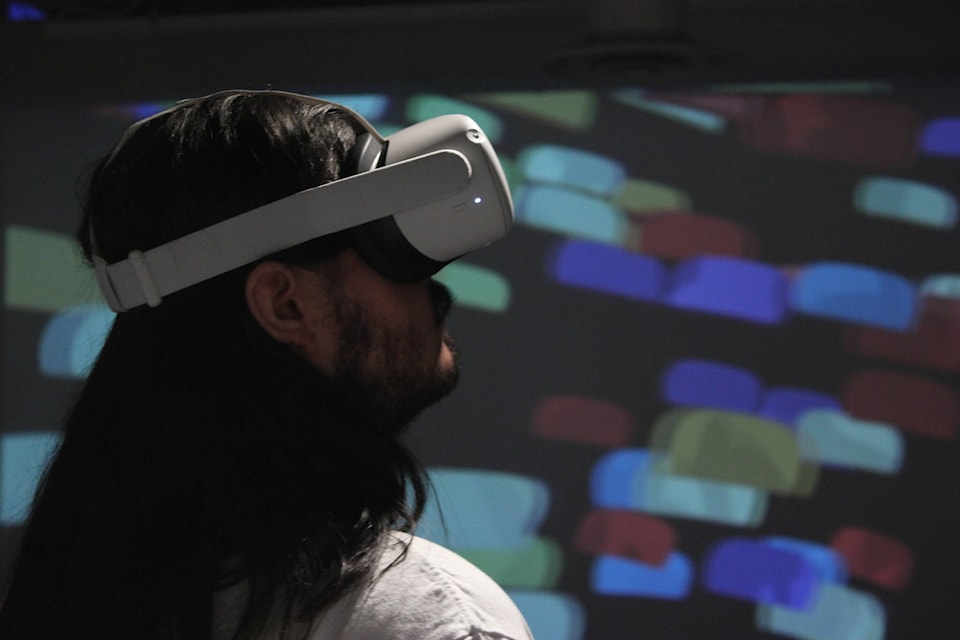Spring officially starts on March 20 and some Yukoners might tell you that the winter weather is not over yet. If you are looking to escape the cold to a new destination, you only need to go as far as the Kwanlin Dün Cultural Centre in Whitehorse.
There you can try slipping into virtual reality (VR) and visiting the world of Coast Salish and Okanagan artist Lawrence Paul Yuxweluptun through his piece “Unceded Territories.”
The VR experience was created by Paisley Smith, a filmmaker and virtual reality creator from British Columbia. Smith was inspired to make a digital landscape out of Yuxweluptun’s paintings when she learned that he had dabbled in VR back in 1992, making “Inherent Rights, Vision Rights” — a work that transports viewers into a traditional longhouse to experience a ceremony complete with music, fire and spirits. Smith considers it a pioneering piece of the VR genre of art.
Yuxweluptun’s art is inspired by Coast Salish traditional works and influenced by the western world.
“Unceded Territories” places participants in a forest full of trees and bears, throwing wet globs of an unknown substance with virtual hands.
“Why are you throwing that oil?” booms the great spirit bear, voiced by Yuxweluptun. “Can’t you see you are hurting Mother Earth?”
The world then bursts into flames and turns black.
“Now everything is dead. No more birds to sing,” the spirit bear chimes.
The whole experience is set to the sounds of Ontario’s Indigenous electronic music duo formerly known as A Tribe Called Red, now called The Halluci Nation.

Ovoidism is the star of the show
As participants approach the VR headset behind black curtains in the Kwanlin Dün Cultural Centre, they are able to stop and take in a short film about the project called “Beyond Unceded Territories.”
The movie explains that the piece of work “pits a ‘Super Predator’ against the environment. But the star of the show is the colourful ‘Ovoidism,’ that evokes Indigenous culture, world view, and relationship with the natural word.”
An ovoid is “one of the basic shapes of traditional Northwest Coast art,” according to the Simon Fraser University Museum of Archaeology and Ethnology in British Columbia.
The shape’s defining characteristics are its concave base, convex top, and rounded corners.
“The Manifesto of Ovoidism” penned by Yuxweluptun and published in 2003, lays out the rules of the art form stating the focus of the Ovoidism style is to “maintain some part of, or all of, the shape of the ovoid.”
The manifesto also says that ovoid painting can be used to make political and joyous statements.
‘The ways of life are taught through the paintings’
Kailen Gingell is a Kwanlin Dün First Nation beneficiary of Tlingit descent and the curator that brought “Unceded Territories” to the cultural centre.
Ginigell says he first learned about Yuxweluptun when he was in art school in B.C. When he started working as the cultural program coordinator at the Kwanlin Dün Cultural Centre he found a book in their collection that features the Coast Salish artist’s work on the cover, inspiring him to seek out Yuxweluptun’s latest project. After reaching out to Smith and messaging back and forth, the exhibit was sent to Whitehorse. That was the first time Gingell ever put on a VR headset.
“It was very surreal checking out something like that,” Gingell.
Gingell says he thinks the artwork is something that a lot of people here at home can appreciate.
“A lot of Kwanlin Dün citizens have that Inland Tlingit descent and ties to the sea and coast. Trading would happen up and down the coast between our people. I thought that the parallels between the more southern coastal style and our styles up here was really interesting,” Gingell explains.
“In our artwork we have a lot of blacks and reds. Down [south] they have more access to colours and then Yuxweluptun takes that another step further with his surrealism,” adds Gingell.
Gingell also says that he thinks the art’s message of interconnectedness is something that is similarly expressed in Yukon First Nations art.
“You can’t have eagle without having the whale,” Gingell said.
“The ways of life are taught through the paintings.”

As for how Gingell interprets the meaning behind the VR piece, “I see it as colonialism and how it really has an effect on the landscape. I know one single person might not have the effect that is really detrimental but once you have a million people acting in a consumerist way, and companies built off of exploiting the landscape, and stuff like that, I think you start to see that the effects are detrimental to Mother Earth.”
Yuxweluptun was not available for comment on the piece. Sources say he is difficult to get ahold of these days, as he may be spending a lot of time on the land and away from technology.
You can check out the VR experience for yourself at the Kwanlin Dün Cultural Centre gallery weekdays from 11 a.m. to 3 p.m. until March 31.
Dylan MacNeil is a CHON-FM reporter and writer based in Whitehorse.
